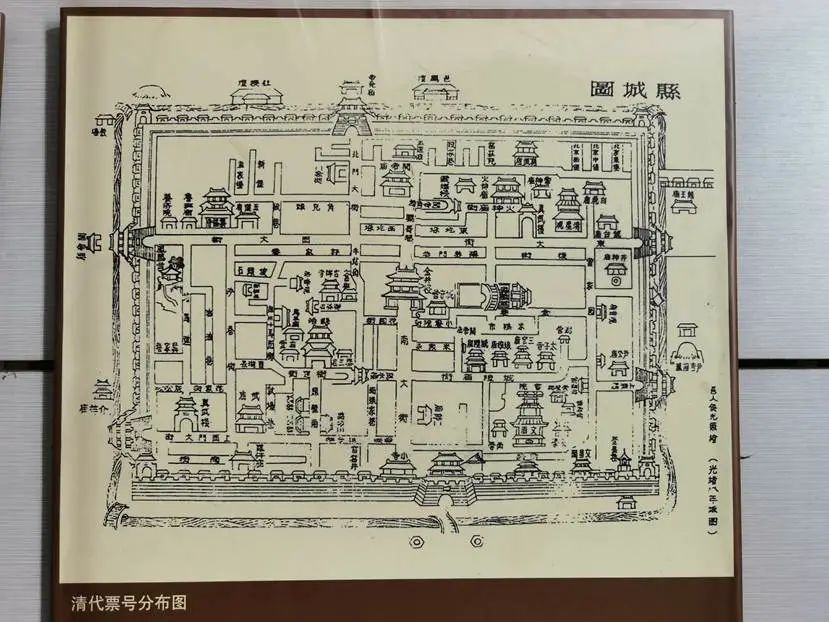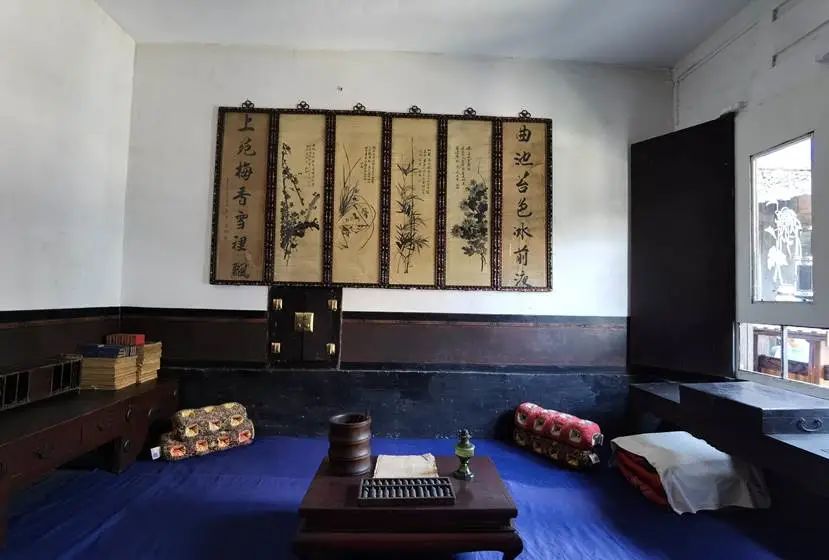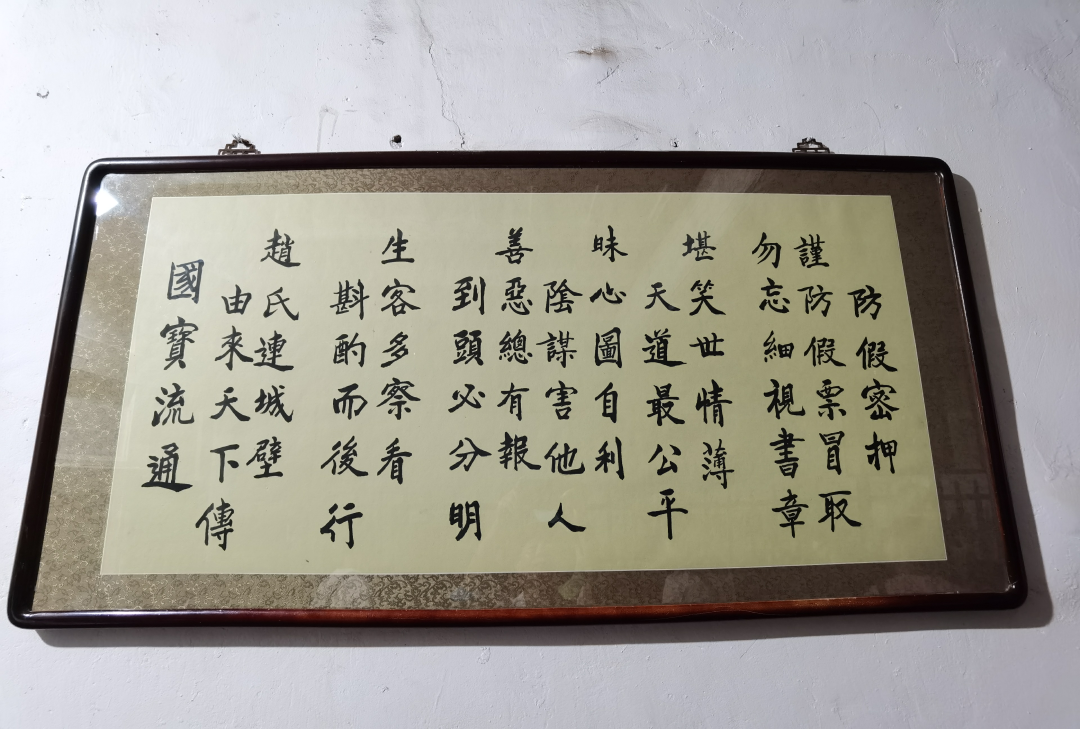
3. Rishengchang Ticket Number
In the morning, we entered the ancient city and continued our sightseeing. Maybe it was time to go to work, and when we entered the city gate, someone asked us to buy tickets. Because we are still the target of Shanxi’s preferential treatment for tourists from Jiangsu, Zhejiang and Shanghai, we don’t need to buy tickets. We only need to register and show our respective ID cards to enter.

The goal this time is to visit the "Rishengchang Bank", which is located near the "market building" in the north of the ancient city of Pingyao, in the bustling area of West Street known as the "First Financial Street of the Qing Dynasty". It is now listed as a national key cultural relic protection unit.

I visited these scenic spots in Pingyao while I was working. Now I am just looking at them to take some photos for my travelogue.

1. Pingyao Ticket Number Museum
The Pingyao County Ticket Number Museum was jointly developed from the former sites of China's first bank, Rishengchang, the second bank, Wei Taihou, and the seventh bank, Rixinzhong. It covers an area of more than 3,820.6 square meters and is one of the three national A world-class museum, it was officially opened to the public in October 1995.

Rishengchang Bank was founded in the third year of Daoguang reign of the Qing Dynasty (1823), specializing in silver exchange and deposit business. It closed in 1948 AD. The prosperity of the bank account led to a large number of wealthy businessmen investing in the bank account. At one time, there were 43 bank accounts in Shanxi, divided into three major groups: Qixian, Taigu and Pingyao. They were located in Dayi, the capital of the country, and as far away as Japan and North Korea. etc., all with semicolons, creating hundreds of millions of wealth for Shanxi. It pioneered the exchange industry in China and drove the development of the financial industry in Shanxi and even the country. After 125 years, it has been the leader in China's finance and is famous for its "Huitong World".

The old site exhibition area of the Rixinzhong Ticket Company displayed in the Ticket Number Museum shows the development history of China's ticket numbers through text, pictures, documents, charts and other forms.

In the exhibition area of the former sites of Rishengchang and Weitaihou ticket companies, precious objects and materials from the same period of the ticket companies are used, supplemented by drawing boards, wax models, and small scenes to restore and reproduce the original appearance of the business activities of the year, providing the audience with an intuitive understanding of the business activities. A place to learn about China’s early financial history.

The former site of Rishengchang and other three buildings, three courtyards and more than 100 houses. It forms a commercial shop courtyard with compact land and clear functions. The main building formed in different construction periods adopts the symmetrical and balanced layout of northern Chinese architecture. From the wooden structure loft with hard roof pavement, to the single-slope large roof atrium, and then to the single-slope large roof back hall, the main buildings are arranged in an orderly manner on the central axis; the east and west cabinet rooms, the account (east), Secondary buildings such as the letter room (west), kitchen (east), and guest room (west) are symmetrically distributed on both sides of the central axis.

It has a wide pavement, a two-story wooden structure, five bluestone steps in front of the door, a thick black painted door, and a deep courtyard that is a little taller than its neighbors. The overall building is beautiful on the outside and beautiful on the inside.

Indoor partitions are completed with finely carved partitions. Brick carving, wood carving, and stone carving techniques are widely used in architecture, making tall and majestic buildings appear light and warm. In terms of room settings, there is a strict distinction between exquisiteness and simplicity. In order to prevent fire, where the flue passes through the gable wall, stone eaves are used instead of wooden eaves.

Out of concern for safety, barbed wire nets have been erected in all areas of the hospital that are considered unsafe. There is a bell on the Internet, and as long as the solid door of the street-facing shop is closed, it is safe.

China's ticket industry, represented by Rishengchang Bank, adapts to the market, operates flexibly, focuses on credibility, is determined to innovate, and has a complete management system. The bank account culture embodies the essence of Shanxi merchant culture. It has the spirit of pioneering and innovation, the courage to separate labor and capital, the atmosphere of selecting and appointing talents, and the courage of honesty and faith. It occupies an important position in the history of my country's commercial and financial development and provides a good foundation for the study of our country. The history of finance provides vivid teaching materials for exploring the reform and development of today's enterprises.

2. The history of “Huitong Tianxia”
Ticket bank (alias: ticket bank, exchange bank) is an old-style credit institution transformed from ancient Chinese commercial capital. Because most of the ticket numbers are opened by people from Shanxi, they are also called "Shanxi Ticket Numbers" or "Western Numbers". (The picture below shows the means of transportation used by ticket shopkeepers when they go out to discuss business and do business)



There is a legend about the origin of the ticket number: "Qing Pi Lei Chao" records: "It is said that at the end of the Ming Dynasty and the beginning of the Qing Dynasty, Li Zicheng was defeated in Shanxi with a huge sum of money and died. Shanxi people obtained his capital to set up a ticket number." It is said that it was in the late Ming and Qing Dynasties. At the beginning, King Li Chuang rebelled. When he was defeated and fled, all the gold was inconvenient to carry, so he put all the gold and silver treasures in the army in the courtyard of the Kang family in Shanxi and left. "The Kang (Kang) family suddenly found eight million taels." , so the side business of Shanxi's exchange was changed to the main business, and a special bank account was created, so the giant businessmen in the area all had the surname Kang. "Maybe this is just a story.

During the Jiaqing period, the White Lotus Sect and the Tianli Sect revolted one after another, targeting the Qing government, causing great panic and uneasiness to shops and businesses that circulated silver currency. According to local historical records, in the winter of the last year of Jiaqing, a business in Hankou transported more than 30,000 taels of silver to the main bodyguard in Pingyao. When they reached the border of Shanxi and Henan, a group of men and horses suddenly came out and tried to seize the escort. After several fights between the two sides, the bodyguard defeated the robbers and safely returned the silver to the main store in Pingyao. The incident of bank robbery has attracted the attention of local merchants and banks in Pingyao, reminding them to find a more convenient and safer way to exchange money.

Pingyao is one of the birthplaces of the famous "Shanxi merchants" in ancient Chinese commerce. Among the many businesses in Pingyao, there is a paint store called Xiyucheng. Its main office is located on West Street in the city. It has been in business for many years and has strong financial resources. It has branch offices in Beijing, Hankou and other places. At that time, Li Daquan, a major shareholder in Dapu Village, discussed with Lei Lutai, who was the manager of branches in Hankou and Jingshi at the time, to learn from the "Fei Qian" of the Tang Dynasty and the "Jiaozi" of the Song Dynasty in the process of exchanging small amounts of silver with fellow villagers, relatives and friends. With the experience, we have overcome the shortcomings of the account bureau that only operates currency lending and not exchange, and gradually summarized a relatively complete set of exchange operation models. When Lei Lutai was transferred back to the Pingyao headquarters as manager, he suggested that the owner change the paint shop into a bank specializing in silver exchange and deposit business. The major shareholder Li Daquan agreed and invested 300,000 taels of silver. Around the third year of Daoguang (1823), he established China's first bank account - "Rishengchang Bank", with the intention of "as the sun rises in the east, business will prosper." .


Rishengchang's couplet from that year:
Rili Zhongtian Wanbao Essence and Yaocai
Ascending to the blessed land, traveling in all directions, living alone in a strange place


In the mid-to-late 19th century, Pingyao Ancient City was one of the cities with the most developed financial industry. It is the location of the headquarters of the most influential bank account in the contemporary era and the place with the highest concentration of financial industry headquarters institutions. A period of time. Once manipulated and controlled China's modern financial industry. The ancient city of Pingyao has had a positive impact on China's modern economic development during its more than 100 years of prosperity.

The method of remittance at that time was that the remitter handed the money to the bill number (or bank), and the bill number (or bank) wrote with a brush and issued a bill of exchange voucher (in triplicate); the important points were coded in code and stamped with an anti-counterfeiting seal. Several pieces; one copy in the middle is sent to the payee, two copies on the left and right, one copy is the stub, and the other is the bill number (or bank) semicolon for sending the remitter's draft to the payee's location; the three copies are stitched There are numbers and seam seals on it. In the future, the payee can withdraw money by holding the bill at the designated bank number (or bank) and checking it against the "money order" without claiming a guarantee. This is called "acknowledging the bill but not the person". Even if the money order is lost or stolen, it can be declared invalid and you can apply for a re-issuance without any loss of funds.

After the Rishengchang Bank was established, it formed a set of management systems of great modern significance, which solved many problems in large-scale silver exchanges. During its golden period of operation, the total annual exchange rate was as high as 38 million taels of silver, which can be described as "a daily profit of a thousand pieces of gold." Inspired by the success of Rishengchang Bank, Shanxi merchants set up or changed bank accounts one after another, which greatly promoted the development of commercial trade at that time. For nearly a century after that, Shanxi Bank basically monopolized the money exchange business of the Qing Dynasty at that time.

3. The decline of ticket numbers
With the close business and relationship with the government, the bank gradually shifted from serving domestic industry and commerce to maintaining its status in the feudal government by recruiting powerful people. The focus of business has also shifted to remittance, lending, deposits and agency business to the government, which has become the financial backbone of the government, and its relationship with commodity circulation has gradually become distant. They no longer care about the exchanges of ordinary merchants and ordinary people, and even stipulate that no exchanges below 500 taels will be processed. This laid the foundation for the subsequent crisis.

Just as the Pingyao bank was in crisis after suffering heavy losses in the Revolution of 1911, the Beijing branch of Qixian Heshengyuan bank was involved in the case. Out of love and to maintain decades of credibility, Hou Yuan, manager of Rishengchang Bank's Beijing branch, came forward to guarantee its debt. The manager of Heshengyuan's Beijing branch disappeared without a trace. The prosecutor's office asked the guarantor Hou Yuan for help. Under coercion and intimidation, Hou Yuan and his friends left Beijing and returned to Pingyao overnight with their accounts. The creditors filed a complaint the next day, and the Beijing branch of Rishengchang was immediately sealed. Subsequently, the Beijing Local Court of Justice sent a letter to the governor of Pingyao County, ordering the Rishengchang Pingyao head office and its owner's property to be seized, and quickly sent someone to Beijing with the account books to clean up.

Guo Shu, the then general manager of Rishengchang, went into hiding, and wealthy business owners Li Wudian and Li Wufeng were imprisoned. Forced to have no choice, Liang Huaiwen, the former associate director who had resigned, stepped forward to rescue Caidong and went to Beijing to report to the trial hall.

During the bankruptcy reorganization of Rishengchang Bank, Liang Huaiwen spoke openly and truthfully, and dealt with the creditors and the judicial authorities. With the consent of the creditors, Rishengchang was temporarily exempted from bankruptcy, with creditors as shareholders, retaining the Rishengchang brand, and resuming business. Liang Huaiwen served as the general manager and barely managed to maintain operations. Except for Beijing, Tianjin and other places, all branches were closed. Soon, Rishengchang changed his business to a bank. Since then, the Pingyao ticket account has begun to decline overall.

4. Secret deposit of Rishengchang number
In Rishengchang's account room, there is a neat calligraphy banner that says "Prevent counterfeit secrets". The tour guide said that the poetic sentences above are one of Rishengchang’s original password characters. This passage may seem ordinary, but its connotation contains infinite mechanisms:

Anti-counterfeit key
Beware of counterfeit bills, and don’t forget to read the seal carefully.
It’s ridiculous that the world is so weak, but the way of heaven is the fairest.
He is motivated by self-interest and conspires to harm others.
Good and evil will always be rewarded, and the end will be fair.
Strangers should observe more and consider carefully before proceeding.
The origin of Zhao's border wall is spread throughout the world.
National treasure circulation

When Rishengchang issued a money order, in order to prevent counterfeiting, it had to be encrypted, and the password was formed using the set of Chinese characters on the wall. After receiving the money order at the bank branch in other places, take out the code book issued by the general bank number and compare it with the year, month, day and relevant uppercase and lowercase numbers cleverly composed of Chinese characters on the money order. If you match them one by one, it means that the ticket verification is successful and it is confirmed. The bills of exchange authentically issued by the head office will be honored one by one. Otherwise, it will be a fake bill and refuse to be honored to ensure the safety of funds.


Rishengchang’s secret secret from that year:
"Beware of counterfeit bills, and don't forget to read the seal carefully." These twelve characters represent the 12 months of the year;
"It is laughable that the world is so unkind, but the way of heaven is the fairest; one is motivated by self-interest and conspires to harm others; good and evil will always be rewarded, and the end will be fair." These three groups total thirty characters, representing the thirty days of the month;
"For strangers, look carefully before proceeding." These ten characters are capital numbers representing one to ten; "The origin of the wall of Zhao's border city is spread all over the world." These ten characters are lowercase numbers representing 1 to 10”;
The last four words "National Treasure Circulation" represent the four capital numbers "one", "ten", "hundred" and "thousand".

Rishengchang has more than 300 sets of such secret deposits, which are used in rotation. The wisdom of the Chinese people can ensure that the money order will not be leaked and the funds will be used safely.

It is a pity that Shanxi's bank did not develop into a modern bank. It is a great regret.

After leaving the ticket office, we went straight to the "Pingyao County Office". An old Shanxi man wearing a red cloth was sitting on the roadside enjoying the cool air and took this photo.

